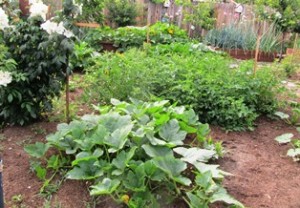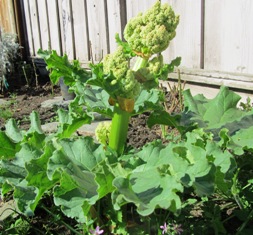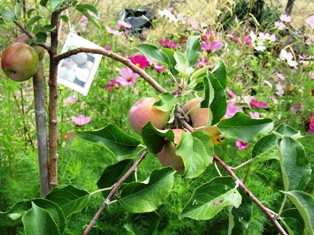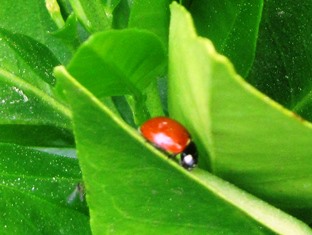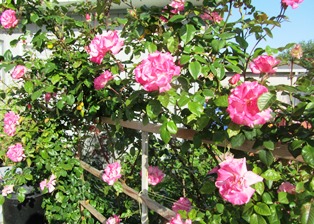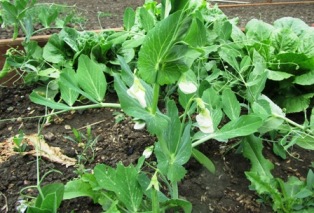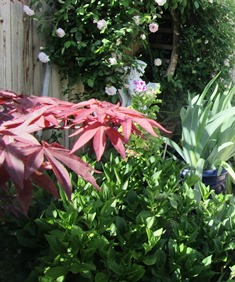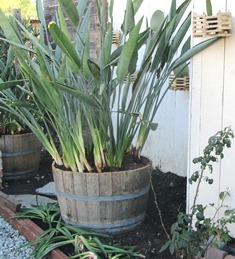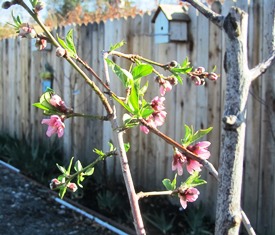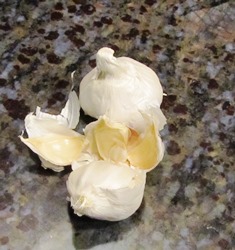Archive for the 'Plants and Trees' Category
Twelve Reasons to Grow Your Own Food
Doctors tell us we should eat fruits and vegetables for our health. Fresh is best. For more reasons to grow your own food, read on.
1. Enjoy Superior Flavor and Higher Nutritional Value
The flavor of produce that travels from your edible garden to your plate is far superior to that of store-bought varieties. Even before fresh produce reaches the bins of your local store, the fruits and vegetables must be picked, sorted, crated, and transported from suppliers t0 supermarkets and grocery stores. Time spent in transporting and storage can diminish food flavors and nutrient values.
2. Keep It Pesticide-Free
Go organic. Choose alternative methods (companion planting and organic sprays, for example) to treat garden pests and plant diseases. Organic farming starts with nourishing the soil, which in turn, nourishes the plants that nourishes a healthy body. Organically grown fruits and vegetables picked fresh, immediately prepared, and served are nutritionally superior than their commercially grown and stored counterparts.
3. Safeguard Your Health
Avoid the cancer-causing agents and toxic chemicals in pesticides that are commonly used on many commercially grown food products.
4. Cultivate Plant Diversity; Preserve History
Grow varieties of the vegetables and fruits you love. Or, choose cultivars that might have grown in your grandmother’s garden–a nod to preserving history. Or, plant varieties that have fallen out of favor, are unusual, or are even rare.
5. Lower Your Food Bill
Grow your own edibles and preserve them for later consumption (like freezing spring peas for a fall or winter meal). Preserving the bounty by drying or freezing or canning can reduce your grocery bills. Another cost and time saver is to grow hard-to-find varieties of heirloom herbs, vegetables, or fruits instead of tracking down sources for those items.
6. Expand Your Knowledge of Plants
Understanding the seed-to-harvest cycle in nature fosters deep appreciation for ecology and the environment and contributes to your knowledge about various plants’ needs for nutrients, water, light, and temperature. You also learn about treatment options for garden-variety pests and plant diseases. This wealth of information can be shared with younger generations who will inherit the responsibility of caring for the planet.
7. Get Exercise
You can still work out, albeit in the garden in the fresh air rather than in an indoors gym. Think about all the exercise you’ll get digging, planting, shoveling, watering, weeding, and composting. Gardening provides plenty of solid exercise and rejuvenates a weary spirit.
8. Reduce Your Stress
Time spent in a garden is restorative: it nourishes your spirit and reduces stress levels. In fact, just a few moments of deep breathing and thinking about birdsong, sunshine, fresh air, and healthy plants all around you–nature in all its splendor–can generate a positive mental attitude.
9. Alleviate Concerns about Food Safety and Quality
You know the quality of the food you bring from your edible garden to the table. You want the superior freshness, flavor, and food quality for your loved ones. The chances for food-borne illnesses of the kind that strike Americans every year and are often investigated by the Centers for Disease Control (CDC) are vastly diminished when you grow organic edibles and eat them as fresh as possible.
10. Preserve Our Planet’s Diversity
Choose seeds that are open-pollinated, non-GMO (genetically modified organism; the result of scientists engineering or modifying the genetic material of food plants). It may come as no surprise that the health of our nation has declined with the demise of small family farms even as there’s been a rise in the number of supermarkets and expansion of modern agribusiness. It’s no wonder people everywhere are getting behind buy-local, keep-it-local movements; participating in farmers’ markets, and engaging in urban homesteading where self-reliance is paramount.
11. Earn Extra Money
Selling your home-grown produce to others in your community means you can make possible the goodness of organic produce to others while earning a little money (hint: buy more seeds or otherwise reinvest in your garden).
12. Feel Good about Donating Excess Produce to a Food Bank
Your local food bank or (sometimes churches, too) will distribute donated produce to needy families. Let it be a source of joy for you that your gardening efforts have literally put food in the mouths of those in less fortune life circumstances.
Growing Peaches in Northern California
What could be more sublime that eating a juicy, ripe peach freshly plucked from the tree? If you have space in your Northern California backyard or garden, consider planting one or more peach trees.
In the Bay Area, peaches are fairly easy to grow. Depending on the cultivar, they are heavy bearing. We planted a classic gold Elberta and some early-bearing Desert Gold peaches two years ago. Already, both trees are loaded with peaches.
I ate a Desert Gold peach off the tree today. It was ripe on one side and still a little crunchy on the other. Another week, and they’ll all be ready for a cobbler. The Elberta peaches will not be ripe until late July or early August.
Peaches are best eaten fresh, in my opinion. But they also freeze well or you can make them into jam, preserve them with spices, or blend up a batch of chutney or baby food. Your best bet is to plant peach trees during bare root season because they are cheaper and more plentiful then. Right now (second week of May), nurseries have replanted their bare root trees into pots.
One of my favorite nurseries in the Bay Area is Alden Lane Nursery in Livermore, California. The nursery carries hundreds of fruit and nut trees and thousands of roses. The oak trees on the property are 300 years old and one has a community of honeybees dwelling in the tree. It’s a great time to visit the nursery. For a list of offers, see http://www.aldenlane.com/media/softprogram.pdf.
Peaches need a lot of sunshine, high nitrogen fertilizer, and water to perform optimally. They also suffer from peach leaf curl, a fungus that can be easily treated with a fixed-copper spray. Dormant oil will control scale if they get it. The trees will live for 15 to 20 years.
Prolific producers, peaches need fruit thinning early on to yield larger fruit and avoid branch breakage. See the University of California’s Master Gardener program tip sheet for more information at http://homeorchard.ucanr.edu/Fruits_&_Nuts/Peach/.
If you love peaches, it’s not too late to plant a tree in your backyard for a bountiful crop of late spring/summer fruit.
Rhubarb–That “Pie Plant”
In my grandmother’s time, rhubarb’s moniker was the “pie plant” for the simple reason that the tart flavor of its canes nicely tempers the cloying sweetness of other fruits.
Rhubarb, long treated as a fruit, is actually a vegetable. In bygone days when tariffs on imported vegetables were higher than on fruit, a New York court decided in favor of labeling rhubarb as fruit for the purposes of taxation and tariff regulations.
One of the first edibles in the spring garden, rhubarb pushes up leaf stalks or canes (what botanists call petioles) with large leaves. The leaves are are high in oxalic acid and thus poisonous to consume (when harvesting, cut off the tops and discard; snap off the canes for cooking).
Rhubarb stalks or canes, when cooked with sugar or apples (to sweeten), are delicious in pies, jams, sauces and fruit tarts.
Rhubarb is easy to grow (in warm climates, it grows year-round). In cold climates, its leaves and canes will die but the rhizome root will generate new shoots come spring. But if it blooms, cut off the bloom to ensure the root continues to produce canes.
The plant can also be grown in large containers or in greenhouses. It is not fussy about soil, produces new canes year after year, and loves sunlight.
Consumers love those red canes, but rhubarb canes, depending on the variety, aren’t always red–some are light green or pink speckled. The flavor of the light green canes, the type growing on our farmette, has the most robust flavor.
While creating a space for some new plants, we decided to dig out one of our rhubarb plants. That little rhizome I put in the ground four years ago had produced roots 20 inches into the earth. Above ground the plant had grown roughly three feet high and as wide. We will divide it and replant, since it’s a good idea anyway to divide every 3 to 4 years.
We grow Victoria, an old variety with a tendency to flower (or bolt). We prefer to remove those flower spikes in order to keep the plant producing new canes and leaves. Blooms tend to waste the plants resources, see http://www.gardeningknowhow.com/edible/vegetables/rhubarb/rhubarb-bolting.htm. Also see, http://www.hort.purdue.edu/ext/rhubarbflowers.html
In an upcoming posting, I’ll include some recipes for using rhubarb from your garden. In the meantime, consider the different varieties available and perhaps try planting a new and different cultivar. See, http://www.rhubarbinfo.com/varieties.
Rooting Plants in Water
I’m a compulsive clipper of plants, knowing that many will send out new roots if placed in a container of water on a window sill. It’s not uncommon for my window sill to fill up with glass jars of cuttings.
With my precious clippings in water, I change the water often to keep it from becoming stagnant.
Among the plants that easily root in water are begonia, coleus, English ivy, geranium, grape ivy, philodendron, pothos, African violet, avocado, and sweet potato.
Several varieties of herbs also root in water: basil, catnip, various kinds of mint, pineapple sage, and watercress.
Bulbs, such as paperwhite narcissus, amaryllis, and hyacinth can be forced to bloom and will also produce roots. Place the base of the bulb on stones or marbles in a dish with water so that the bulb’s base sits on the water’s surface. The roots will grow downward, so you must always ensure there is adequate water.
Take care when putting your cuttings into soil so as not to damage the fragile, newly formed roots. Once you see how easy the process is, you might find your window sill filling up with cuttings in water, too.
California’s Farmers Markets Offer Fresh and Tantalizing Fruits and Berries
Eating fresh means growing it yourself or purchasing the food for your table direct from its source. California farmers’ markets offer a dazzling variety of fruits, vegetables, and nuts directly from local area farmettes, orchards, small and commercial farms, specialty growers, and ranchers.
Many fruits and vegetables are certified organic. That means the farmers and growers are registered and in compliance with state and local regulations designed to protect consumers and ensure food quality and safety.
Annually, California produces nearly half of the nation’s fruits, nuts, and vegetables, according to the California Department of Food and Agriculture. See http://www.cdfa.ca.gov/Statistics/
The San Joaquin Valley of central California has earned the moniker of the World’s Food Basket since its crops account for 12.8 percent of all agricultural products from California.
In fact, California leads the nation in production of figs, dates, plums, melons, nectarines, peaches (Clingstone and Freestone), pears (Bartlett), persimmons, raspberries, and apricots.
In the Golden State, you can find dozens of types of fruits offered at 350 farmers’ markets (some open all year long). For a list by county, see http://www.pcfma.com/markets.php.
From the Pacific Coast Farmer’s Market Association, the following list (recapped below) reveals when these fruits are in season in California.
Apples: January-February; August-December
Apricots: May-July
Blackberries: June-September
Blueberries: May-August
Boysenberries: June-August
Cantaloupe: May-September
Cherries: April-June
Citrus: January-March; November-December
Dates: September-December
Figs: September-November
Grapes: August-November
Kiwi: January-April; October-December
Melons: June-September
Nectarines:May-September
Peaches: May-September
Pears: September-December
Persimmons: September-November
Plums: May-October
Pluots: May-September
Pomegranates: September-November
Prunes: May-September
Raspberries: May-October
Strawberries: February-November
Watermelon: July-September
The Benefits of Bamboo

Bamboo plants make great screens, clipped hedges, or a dramatic foil for plants layered in front of it.
Bamboo plants are favored by environmentalists because they are drought tolerant, can be used for erosion control, are not fussy about soil, make fast-growing hedges or screens, and quickly naturalize.
We grow mainly the clumping type of bamboo because it makes very little horizontal growth and stays tightly clumped. It just gets dense.
The runner type, however, spreads through underground stems that grow out from the rhizome. These are the types of bamboos that reach considerable heights and form groves.
Dividing the plants helps maintain control of these woody-stemmed giant grasses.
Spring is the best time to divide bamboo plants. Although spring is still a few days away, we are dividing the bamboo that thrives along our farmette fences and planting it as a screen on the side of the house where we can see traffic from the road.
Although bamboo has gotten a bad rap for spreading into areas where it isn’t wanted, it can be confined in containers or by inserting metal or concrete barriers into the soil to prevent unwanted invasion by the runner type.
The plant’s evergreen leaves on tall, slender stems look graceful swaying in the breeze and, coupled with its other benefits, make bamboo a good choice for some landscapes.
Have You Planned Your Garden Yet?
Ladybugs and honeybees occasionally meet on the same leaf when both forage for food. The ladybugs dine on aphids while the honeybees seek the sweet nectar of blossoms; orange, tangerine, and lime trees are favorites.
The bug and bee traffic has been steadily increasing now that showers and warm weather have triggered blossoms opening on the fruit and citrus trees around the farmette.
Spring doesn’t officially begin until March 20, but with the weather forecasters predicting upper 70’s Fahrenheit later this week and nighttime temperatures in the 50’s, it is time to consider options for your garden. Many DIY centers are already offering vegetable seedlings, herbs, and berries for planting. Some have markedly discounted their bare-root fruit trees and roses.
I’ve already planted seeds in flats for germination and scattered flower seed (collected from last summer’s flower garden) around prepared beds. When the outside temperatures start to climb, I’ll be rewarded with blooms from nasturtiums, petunias, zinnias, and sunflowers.
The climbing roses are already past the red-leaf stage and are producing the first flush of blooms for spring. The wisteria vines have plump pods ready to unfurl with gorgeous tracts of purple blossoms. And the first green tips of leaves are beginning to sprout on my apples even as the early peaches and apricots already have fruit forming.
This time of year holds the promise of new beginnings, and you see that in every step you take in a garden. Because I prefer to grow plants from varieties of heirloom, open-pollinated seed, I save it from the best specimens grown in the previous season. Of course, some plants freely re-seed themselves. That’s why I now find lettuce and onions and even sweet peas coming up in expected places on the property.
Have you figured out what veggies, flowers, fruits, and berries you’ll plant and grow in your garden this year? If not, now’s a good time to get started. For ideas, check out, http://www.organicgardening.com/learn-and-grow/plan-beautiful-vegetable-garden.
If you prefer, as I do, the non-GMO and organic seeds, there are many excellent sources for them. For heirloom and rare seed, check out http://www.rareseeds.com/store/vegetables/. Also see, http://www.victoryseeds.com/aboutus.html and http://www.anniesheirloomseeds.com/
Telltale Signs of Spring
As I write this, the honeybees are scouting every plant on the property. Awakened by warm weather and sunlight, they search for nectar. Aside from a few California poppies and other wildflowers blooming in front of the house, they won’t find much to forage on just yet.
Of course, there are a few apricot, nectarine, and almond tree blossoms as well as a smattering of white strawberry blooms in the raised beds at the back of our property. But within a few weeks, the warm weather of March and April will render the farmette virtually covered in masses of sweet offerings for the honeybees.
Still, there are the early signs of spring. The Japanese maples are leafing out in a dazzling show of red color. The pregnant stems of our bearded iris are swelling now for their Easter bloom cycle. And the Greek oregano is popping up everywhere as it does this time of year.
Birds are building nests, but I haven’t seen the red-breasted robins just yet. When they show up, searching for worms and grubs, I will know spring has truly arrived. Until then, I look for the telltale signs that Mother Nature is about to robe herself in the splendid garments of spring–fruit tree blossoms, leaves, blooming wildflowers, and lovely kitchen herbs pushing up all over the place.
Tell the Plants to Go Back to Sleep . . . It’s Still Winter
It’s beach weather along Northern California’s coastline and bare root season technically won’t start for another few weeks. It’s the last Saturday in January–still winter. But the plants are waking up all around Henny Penny Farmette, thanks to the record-breaking, unseasonably warm weather.

Narcissus are grown from bulbs and when massed together in plantings return year after year in a cheerful splash of color
The narcissus seem to have popped up overnight. We tucked three dozen bulbs in a bed the first fall we lived on the farmette. The next spring, they bloomed. Their tall stalks and leaves die during summer, but every spring they emerge to bloom again, creating a dramatic drift of color.
Who doesn’t love working in shirt sleeves? But our gardens need rain and we need the plants to remain dormant while we finish winter chores and get our new chicken house ready.
This week, we finished dividing the strawberries and irises, cutting back the roses, and spraying the fruit trees again.We created another sitting area in the garden under a large apricot tree, laid a gravel floor, and planted Bird of Paradise (Strelitzia reginae) plants in half barrels.
Bird of Paradise plants (also known as crane flower) are indigenous to South Africa. The plants are heat lovers and aren’t too fussy about soil. Planting them in containers is a good idea if you live in an area, as we do, where the winter temperatures fall below 50 degrees Fahrenheit. You simply move them indoors.
The Bird of Paradise foliage makes a nice foil for the plant’s striking blooms of orange, fuchsia, and purple that resemble a crane’s head and beak.
I think it’s too late to tell the plants to go back to sleep. So even if it’s torture to spend a long, languorous day digging in my garden in my shirt sleeves, while the rest of the country is freezing, I suppose I simply must soldier on.
What’s Not to Like about Garlic?
The use of garlic (Allium sativum, an herb) was well known in the ancient world as a flavoring agent for food as well as a powerful medicinal aid. In fact, the ancients believed garlic was especially beneficial in the treatment of such maladies as indigestion, respiratory ailments, parasitic infections, and fatigue.
Modern scientific studies have shown garlic to be an effective agent in reducing blood pressure and high cholesterol. People have also used it in the treatment of tuberculosis, bronchitis, dysentery, liver ailments, diabetes, and rheumatism. Some believe garlic slows the progression of artherosclerosis (hardening of the arteries). Garlic can work like a blood thinner, and thus, it might be a valuable agent in preventing strokes and heart attacks.
Emory University School of Medicine researchers discovered that Diallyl trisulfide found in garlic oil helps to protect the heart during cardiac surgery and after a heart attack. The compound also seems to have cancer fighting properties.
Garlic kills cancer cells in test tubes. It may also lower the risk of developing colon cancer. See, http://umm.edu/health/medical/altmed/herb/garlic
A research study in China used anecdotal evidence to support the belief that eating raw garlic more than twice a week can lower the risk of getting lung cancer by 44 percent. The research was published in the journal Cancer Prevention Research.
Garlic is rich in antioxidants. Garlic oil, according to research published in the Journal of Agriculture and Food Chemistry, potentially could be used to prevent diabetes-induced cardiomyopathy, although the researchers say further study is needed. Diabetics are at higher risk for developing cardiomyopathy, a thickening of the myocardium that makes the heart become enlarged over time and less effective as a pump.
Long valued as an anti-inflammatory agent, garlic also strengthens the immune system. When taken as a prophylactic, garlic is believed to reduce the number of colds people get during the cold and flu season.
I am not a medical doctor but I believe eating a wide variety of herbs, vegetables, fruits, grains, and nuts for their nutritional value. Of course, the closer the food is to being organic and fresh, the better it will be for the body.
Garlic is easy to grow. It needs full sun, good drainage, and rich, loamy soil. In the fall, plant the cloves two inches under the soil and six inches apart clove pointed upward. Water weekly.
The cloves will grow in the spring and are ready to harvest around mid June to July, when roughly 3/4 of the top growth has turned yellow. Hang four to six weeks to cure. Keep a braid of garlic in kitchen for use in your culinary creations.
 Facebook
Facebook Goodreads
Goodreads LinkedIn
LinkedIn Meera Lester
Meera Lester Twitter
Twitter




